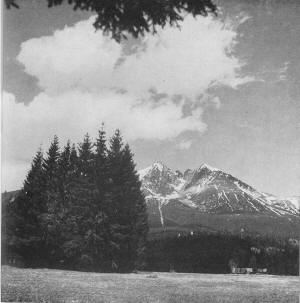Previous
UNDER
THE CARPATHIANS
HOME OF A FORGOTTEN PEOPLE
Dethroned Capital
Next
Previous | UNDER THE CARPATHIANS HOME OF A FORGOTTEN PEOPLE
Dethroned Capital | Next
|
In 1919, when Carpatho-Ukraine at last became a semi-autonomous unit, the inhabitants of Mukacevo expected that their town would become its capital. They had a good case. Mukacevo was then the most populous town of the province ; its geographical position was more central than that of Uzhorod, the only serious rival ; moreover, the part it had played in the more remote past supported, to some extent, its claim to the title of the country’s historical capital.
What is known about the early beginnings of Mukacevo is a mixture of legend and fact. Presumably, towards the end of the fourteenth century, if not earlier a large group of Ukrainians, led by Prince Koryatovich, left their native country, fleeing from the Latvians, and arrived in the valley of the river Latorica. They liked the fertile country, decided to settle there, and were soon followed by other colonists. in the course of a hundred years or so the new settlement, Mukacevo, became a sizable place. The colonists seem to have been doing quite well and, although nominally subjects of the Hungarian Crown, they enjoyed certain privileges. As a thanksgiving for their good fortune they began to build a monastery, which is preserved to this day.
It is an historical fact that at the end of the fourteenth century part of the province was administered by a liege lord of Ukrainian blood, who styled himself “ Prince of Mukacevo.” This imposing title was retained by his few successors, but as time went by, their authority waned and ultimately they were no more than governors appointed by the King of Hungary. Mukacevo also became the see of the first bishop and played an important part in the country’s religious.
This thin gilding, which lent some distinction to Mukacevo’s beginnings, gradually wore off and disappeared completely when Carpatho-Ukraine forfeited what administrative unity it may have had and was split into four separate counties. The town’s prestige declined further when the bishopric was transferred to Uzhorod. Still, under Hungarian rule Mukacevo was the largest town, though only by a slight margin, and an important trading centre of Carpatho- Ukrainian territory.
From 1919 on, when Carpatho-Ukraine was joined to Czechoslovakia, the citizens of Mukacevo strove hard to assert their town’s claim to the status of capital, but their efforts failed. The Czechoslovak Government preferred Uzhorod, which was nearer to Prague, as the centre of the Carpatho-Ukrainian administration, and Mukacevo was superseded.
 In spite of this setback, Mukacevo made much headway In the period between the two wars. its population increased by fifty per cent to roughly 32,000, nearly one-half of whom were Jews, almost one-third Ukrainians and one-sixth Magyars. In keeping with their cultural and social programme, the Czechoslovak authorities built two new secondary schools, a higher agricultural school, a modern hospital for adults and one for children. Industrially, too, the town made some progress, thanks mainly to the development of the State tobacco factory which the Czechoslovak authorities fostered in their own interest.
In spite of this setback, Mukacevo made much headway In the period between the two wars. its population increased by fifty per cent to roughly 32,000, nearly one-half of whom were Jews, almost one-third Ukrainians and one-sixth Magyars. In keeping with their cultural and social programme, the Czechoslovak authorities built two new secondary schools, a higher agricultural school, a modern hospital for adults and one for children. Industrially, too, the town made some progress, thanks mainly to the development of the State tobacco factory which the Czechoslovak authorities fostered in their own interest.
The centre of Mukacevo is, on the whole, town-like in appearance. The houses in the paved main streets ate for the greater part two-storied and were in good repair before the war ; there were several very modern public buildings, a number of good shops, cafes, restaurants, hotels, cinemas, and the inner quarter was well lit at night.
Yet all this recent development seems to have been somewhat incongruous and sudden. A quarter of a century ago the would-be capital was a backward and neglected provincial town ; its outskirts, with their unpaved streets, resembled a village where geese and chickens were no unfamiliar sight. in spite of the recent swift progress, traces of rustic life did not entirely disappear, and the hothouse modernisation introduced from the west made little more than a superficial impression on this substantially eastern town. Even at the peak of its development Mukacevo was a place of striking contrasts where the new clashed with the old, the town with the village. Although there were good shops in Mukacevo’s “ West End,” much of its bustling trade was done in the open. During the main shopping hours the town was one large bazaar where all manner of goods were displayed either on street-stalls or on the pavement. The people who thronged the streets were a motley crowd. Townsfolk in ordinary clothes mingled with peasants In traditional dress who came to town to sell their produce, while white-bearded and whiskered Jews in kaftans
shouted themselves hoarse praising their variegated wares. From a hill near by, the old castle of Mukacevo looks down upon this striking medley with the unruffled dignity of age. Its massive structure has weathered many a storm and has been put to a number of uses in the course of centuries. These changes in the castle’s function reflect, in a way, the changes in the town’s fortunes. Once the seat of the “Prince of Mukacevo, the castle was, later, used by the Hungarians as a gaol for political prisoners ; the Czechs turned it, at first, into an historical museum, but when war became a distinct possibility the ancient stronghold had to serve as a military barracks.